Sir Thomas Wyatt is trapped by his own conflicting desires.
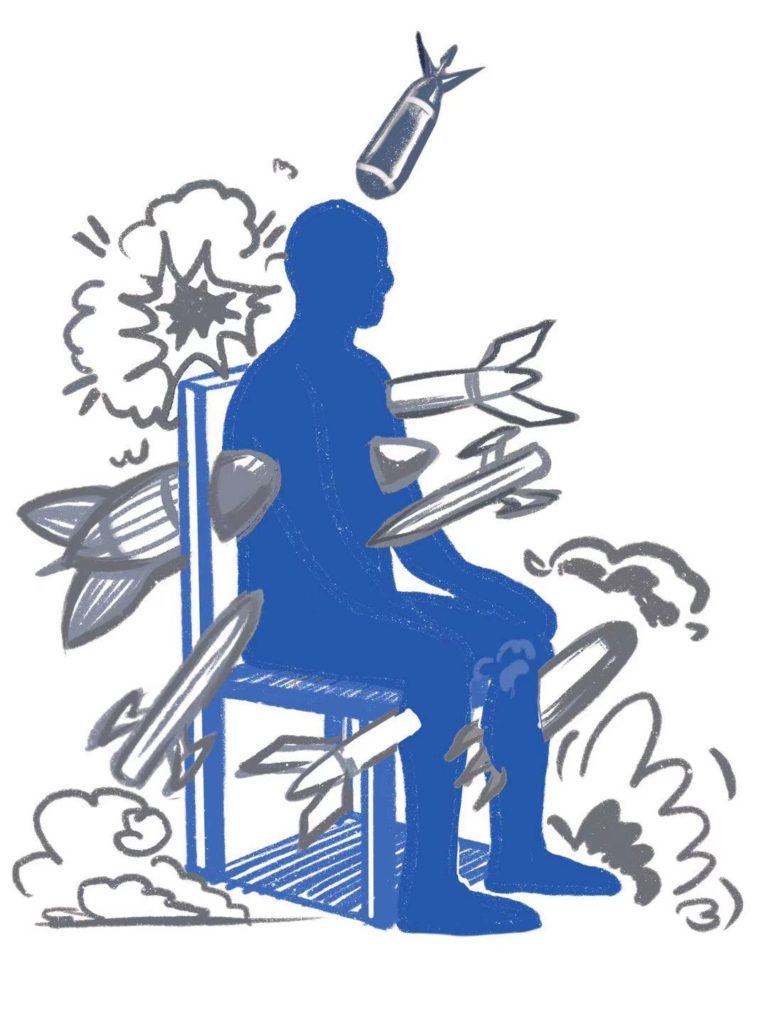
“[Their relationship] was much warmer and more dangerous to Wyatt than the courtly exchange of trinkets”
Nicola Shulman, Wyatt’s biographer on his association with Anne Boleyn, wife of Henry VIII
Have you ever wanted something – really, really badly wanted it – only to find that the price is too high? Perhaps you have a fondness for junk food, sweets, chocolate or cake – you know it’s bad for you, but you can’t help sneaking that extra slice? Or, if this doesn’t strike a chord, imagine really liking someone and finally getting that long-anticipated first date… only to find yourself casting admiring glances in someone else’s direction instead. These are the types of emotional conundrums tying Sir Thomas Wyatt up in all kinds of knots and leaving him stuck in a deep psychological rut. I Find No Peace is especially interested in the contrariness of people, always wanting what they haven’t got or what they shouldn’t want. If, perchance, they should get what they desire, they suddenly realise it’s not worth the pain. Read the poem first, then I’ll tell you what it was that caused him so much distress:
I find no peace, and all my war is done. I fear and hope. I burn and freeze like ice. I fly above the wind, yet can I not arise; And nought I have, and all the world I season. That loseth nor locketh holdeth me in prison And holdeth me not – yet can I scape no wise – Nor letteth me live nor die at my device, And yet of death it giveth me occasion. Without eyen I see, and without tongue I plain. I desire to perish, and yet I ask health. I love another, and thus I hate myself. I feed in me sorrow and laugh in all my pain; Likewise displeaseth me both life and death, And my delight is causer of this strife.
Born in 1509, Thomas Wyatt lived in the time of the English Tudors. His father was an advisor to Henry VII and Thomas himself was friends with Henry VIII’s chancellor Cromwell. Amazingly, Thomas was imprisoned by the King for suspected adultery with none other than Anne Boleyn – King Henry’s wife and the Queen of the realm! He was later released without charge or further punishment, but it seems that he got very lucky. From his cell in the Tower of London he may have been able to witness Anne’s execution, along with the deaths of five others with whom she was accused of having affairs. You can spot allusions to this story in the poem: he mentions being holdeth in prison and admits I love another. It’s tempting to interpret the final line of the poem (My delight is the causer of this strife) as a kind of ‘explanation’: Anne Boleyn is his delight and he ends up in trouble (strife) because of her.
However, while it certainly appears that a forbidden or transgressive love is the reason for his internal struggle, I caution you against trying to impose a literal interpretation entirely onto the poem. One reason is that, while Thomas wrote poems that could have been shared and read around the King’s court during his lifetime, he was first published in 1557 – after his death from illness at the age of 39. Generally speaking, when analysing poetry, you should let the words of the poem speak for themselves, rather than try to explain everything biographically. So, even without knowing any of this context, you can explore the ways I Find No Peace asks big philosophical questions: why are we predisposed to want what we can’t have? And, even if we get it, why can’t we ever feel satisfied? The poem conveys the impression of a person caught perpetually in two minds, trapped by the knowledge that the things that might make him happy are also the things that bring him the most grief.
Wyatt fills his poems with all kinds of juxtapositions, contradictions and contrasts, oppositions and oxymorons which, when unspooled over fourteen consecutive lines, combine to create the impression that human beings are contrary creatures with some quite impressive emotional issues. The major poetic device Wyatt employs to render his internal conflict is contrast. Actually, I don’t think there’s a single line in the whole poem that doesn’t contain a contrast of some sort. Glance through the first four lines (a group of four lines is called a quatrain) and you’ll see: war vs peace, fire (burn) vs ice, hope vs fear and ‘having’ vs ‘not having.’ Many of these contrasts are binary oppositions (meaning they mirror each other perfectly; another name for a binary opposition is antithesis), such as burn and freeze or war and peace. Placing these opposing extremes together (juxtaposition) conveys the impression that the speaker swings wildly from one position to another and is never content in his emotional state. Sometimes he pairs opposing concepts to make oxymorons (two concepts that when placed together form a paradox) such as in line four in which a person has nothing (nought) and everything (all the world) at the same time. To begin with it’s difficult to draw connections between such extreme opposites; but it’s important to appreciate that opposition is a form of connection. Heads and tails are two sides of the same coin, left is the same as right when viewed from a different angle, and without the concept of war there could be no peace. As such, lines of poetry that seem to present impossible situations in fact illuminate the idea that people actually exist in a constant state of paradox. We feed when it’s not good for us, laugh when we’re in pain, love those we’re unable to find happiness with, and even feel trapped when we’re really free… or is it the other way around?
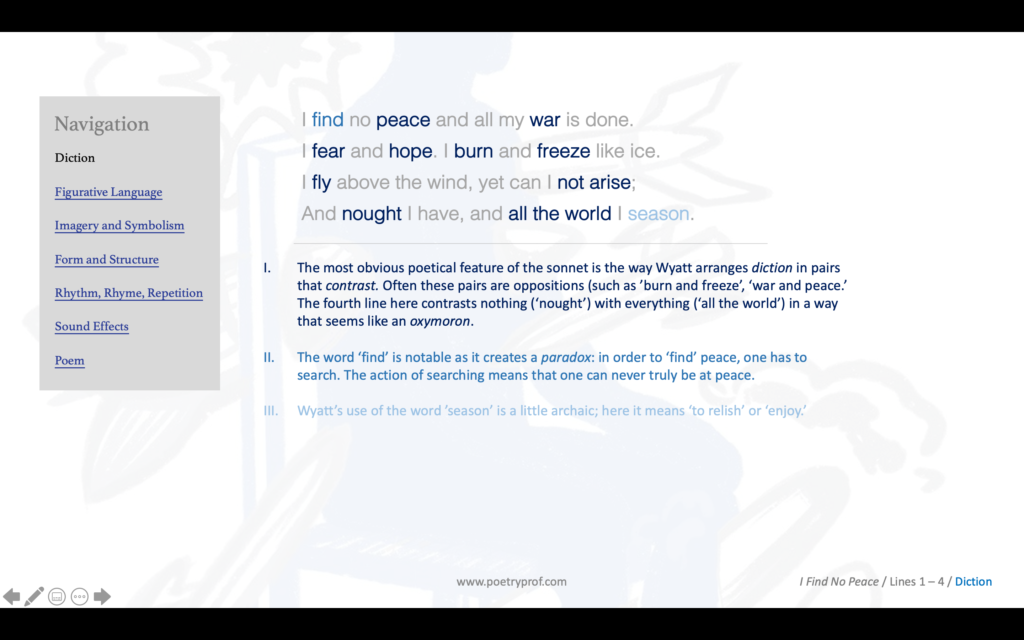
With this in mind let’s try to unpick a couple of these abstract paradoxes and understand how they encapsulate true aspects of human experience. The first line, for example, reads: I find no peace, and all my war is done. There is an obvious contrast between peace and war and the sentence reads like an oxymoron; how can one not be at peace if war is finished? But human lives are rarely so simple. Imagine needing conflict to fulfil some kind of psychological need. There are plenty of accounts of soldiers who head straight for the fiercest battlefields or willingly volunteer for the most dangerous missions. It’s easy to imagine how someone like this would find it hard to feel peace in the absence of war. Instead they would be restless, itching to move on to their next adventure. Another way of considering this line is to consider a calm face behind which a person might hide roiling emotions (having to maintain a dignified outward appearance while imprisoned in Henry’s terrifying dungeon is an obvious referent point here). You don’t even have to interpret this line so literally. After all, overcoming challenges is an important way of learning and the notion that a person might never be able to attain peace (perhaps meaning ‘satisfaction’ or ‘contentment’) if there was never any ‘challenge’ (war) to stimulate one’s growth is not too hard to accept. This line uses and as a conjunction that connects the two oppositions: the repeated use of conjunctions and connectives (and, yet, and yet, and thus) through the entire poem encourages us to make logical and thoughtful links between seemingly dissociated ideas.
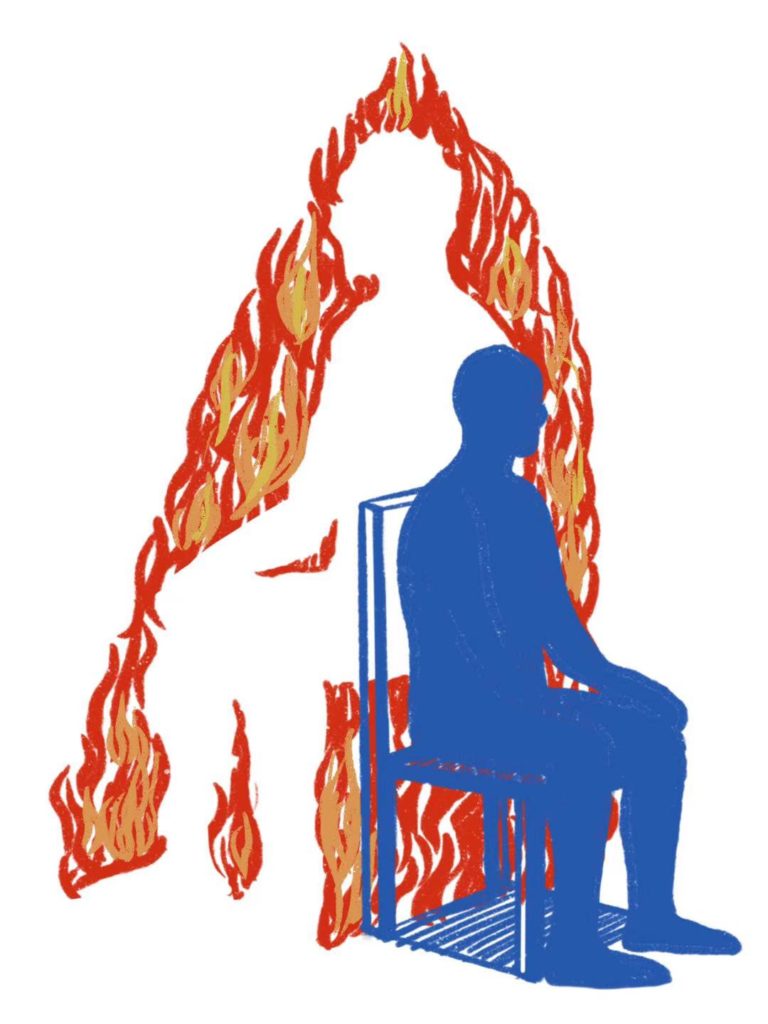
The second line also rewards careful consideration. It presents two seeming oxymorons: fear is a negative emotion while hope is positive; burn and freeze are binary oppositions again. Let’s think about these in turn. Firstly, our emotional landscapes are not simple and it’s entirely possible for a person to feel two conflicting emotions at the same time. More, might not an emotion such as hope be created through fear? Think about the things you hope for: success at school or at work; romance; opportunity – I’m sure you have your own hopes and dreams. As soon as you feel the hope that you might actually achieve something, doesn’t the fear of failure automatically creep in? And isn’t the reverse also true? Whenever you are afraid, fall behind, get trapped or feel helpless – those are the terrible conditions under which hope is born. In Thomas’ case, it’s not hard to understand how his hope for some kind of relationship with Anne Boleyn would also cause no small amount of fear!
The second paradox in this line is even easier to resolve; if you’ve ever touched ice that’s really, really cold, you’ll know that it can burn just like fire. Strong emotions like love, desire and lust can seem to both burn and freeze at the same time. Once again, what seems to be a paradox is, after a moment’s thought, revealed to be a simple truth. The same goes for the fifth line, which juxtaposes the state of having nothing (nought) with having everything (Wyatt uses the word season in a way that we don’t anymore, meaning ‘to relish’ or ‘enjoy’) in a way that seems like an oxymoron. But all you have to do here is think about a person who may not have any material wealth yet is, at the same time, unburdened and free to explore other things the world might have to offer. A student who takes a year out to go backpacking, a person who donates all his or her money to charity, an itinerant wanderer, (or, perhaps, a man who has risked everything to briefly taste a forbidden love) could easily explain how this paradox is possible. Therefore, Wyatt’s use of oxymoron, contrast and paradox doesn’t present an impossible world at all – he’s simply asking us to consider how human feelings and experiences are more often a blend of complex colours rather than simple black and white.
This complexity of mind, heart and psyche means that we find it very difficult to attain a state of satisfaction or contentment. More, Wyatt believes that we bring existential unhappiness and disappointment down upon ourselves; he posits that it is the very search for contentment and satisfaction that is the cause of distress in our lives. Look carefully at the title and note the word find – a verb that implies action. In order to find peace (which you can interpret any number of ways, such as ‘tranquillity’, ‘rest’, ‘enlightenment’, ‘happiness’ and so on) one must search for it, and the very action of searching makes a state of peace or rest impossible. You can’t be both moving and still at the same time. The poem presents this fundamental irony as an inescapable part of the human condition, and Wyatt repeatedly shows us, using a range of different metaphors, how people act against their own interests. In an example from line four, Wyatt imagines flying above the clouds, yet the line ends with the assertion that he can’t fly (yet can I not arise). It’s only through imagining that we might be capable of flight that being stuck on the ground becomes disappointing – or it’s only once imprisoned that one becomes painfully aware of the freedom that one has lost. Later, he suggests that it’s in the hope of finding love that being alone becomes unbearable. This is his portrayal of the ‘human condition’: our strengths – such as the ability to imagine alternative realities, or to feel love, or to have hope in the future – are also our Achilles’ heel. This idea is, in fact, the culminating thought of the whole poem: my delight is causer of this strife.
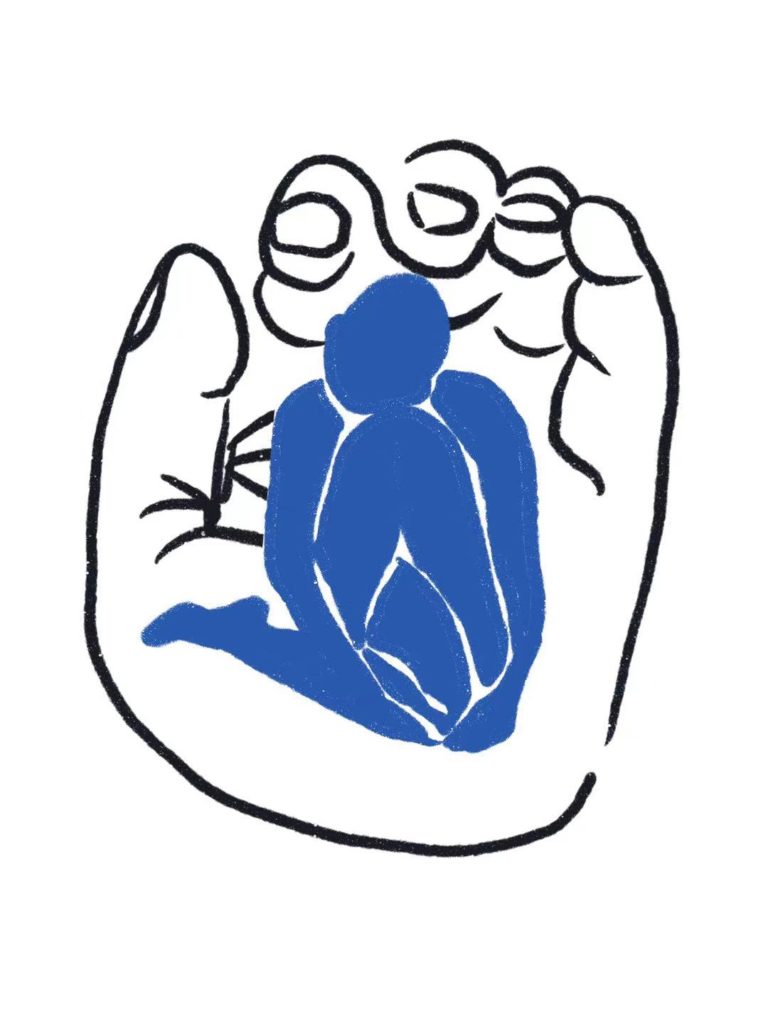
Wyatt’s existential despair is felt most keenly in the second quatrain, which introduces the idea that the speaker is either free but feels trapped, or is trapped in a prison of his own making. The story of Wyatt’s (alleged) affair with – or even just his dangerous admiration for – Anne explains this line perfectly! But it’s also possible for somebody to feel trapped by invisible bars, the kind brought on by pressure at work or family expectations. Remember, even the simple act of searching means that he can find no peace, so the more he searches for a way out of this cage, the more powerfully he feels the bars close in around him. The phrase yet can I scape no wise (which you can read as ‘but there are no ways for me to escape’) is the emotional high-point of the poem for me, a desperate cry of frustration, isolated and emphasised – or imprisoned? – by two hyphens. The technical name for an unexpected break in the middle of a section of poetry is caesura; it’s employed here to highlight the futility of his contradictory feelings.
Being torn between extremes, confounded by contradictory possibilities, and trapped by one’s own uncontrollable desires takes a toll on a person’s psyche so, perhaps as a final chance of escaping that symbolic prison, the speaker’s thoughts turn to death. Already dark and depressing diction (locketh and holdeth) darkens further to die, hate and perish. But even here there seems to be no possibility of respite. Despite living in a world full of dangers (and yet of death it giveth me occasion suggests many of these dangers might have been lethal) the speaker seems unable to exercise his own right to choose his destiny (nor letteth me live or die at my device). Instead, he is subject to human survival instincts as, even when dying seems preferable to a life of sorrow and pain, people strive for self-preservation: I desire to perish, and yet I ask health. I can imagine how, supposedly, being able to see Anne Boleyn die from his cell in the Tower of London would have made him feel wretched, as if he deserved the same punishment – yet at the same time desperate to avoid that terrible fate himself. At the end of the poem, he is so exhausted by all this that life and death end up meaning pretty much the same to him, both likewise displeasing. I’d say his tone at end of the poem is resigned more than anything else.
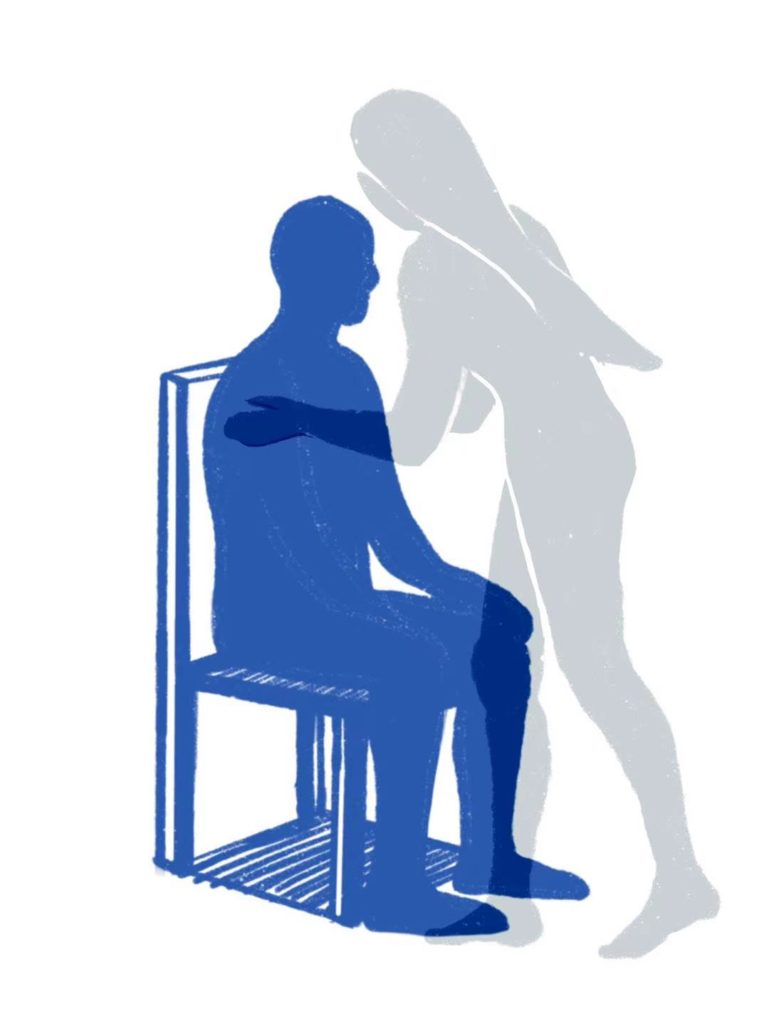
I mentioned earlier that all this angst is framed by the sonnet form. In fact, Wyatt was one of the earliest proponents of the sonnet form in England, translating and adapting many sonnets from Europe and helping to ‘import’ this form into English poetry. This poem is Wyatt’s version of a fourteenth century Italian poem, Pace non trovo e non ho da far guerra, by Petrarch. Petrarch, after whom the Petrarchan sonnet variation is named, often wrote about unrequited love. (Famously, his sonnets featured a woman called Laura who was beautiful but unavailable; if the stories are true, Anne Boleyn is Wyatt’s own Laura figure). Pining after unattainable women and suffering the pain of rejection became something of a literary archetype, now called a Petrarchan Lover, and it seems that Wyatt’s speaker, especially if he’s an avatar for Wyatt himself, has fallen into this trap. He says I love another, but this love prompts its equal and opposite emotion (hate) as well. The word thus in this line suggests cause-and-effect: it’s because he loves somebody unattainable (and who could be more unattainable than the King’s own wife?) that he comes to feel such hatred for himself and, I suppose, his own uncontrollable desires. Substituting the word ‘love’ for delight when reading the last line supports this reading too – once again the poem shows how people bring emotional strife down on themselves, this time by chasing after someone who won’t (or shouldn’t) return their love.
Sonnets, whether Petrarchan or otherwise, are written in iambic pentameter. An iamb is a unit of two syllables, arranged unstressed-stressed, and this beat pulses through the whole of the poem. The repetitive paired measure underpins all the dualities in the poem, and acts as a kind of prison for the words, in the same way that Wyatt feels his desire has become a prison for his soul. Occasionally the meter varies; read the poem clearly out loud and you’ll hear how, in several places, there is a sudden quickening. Here’s a line with the stressed beats marked for you:
That lōs/ eth nor lōck/ eth hōld/ eth mē/ in prīs/ (on)
You can see how –eth nor lōck contains three syllables rather than two, as if, like in music, a single crotchet has been split into two quavers, creating an unstressed-unstressed-stressed arrangement. This kind of measure is called an anapest, which makes it seem like the words are straining to break free of the prison of the prevailing iambic rhythm.
Lines of pentameter means there are always five stressed beats; the lines are long enough for Wyatt to organise his impressive paradoxical phrases. We’ve mentioned binary oppositions and oxymorons – but the poem contains all kinds of other dualities, even down to dualities in grammar. Take lines nine to twelve (the third quatrain) which are arranged in identical grammatical structures called parallelisms. Here’s how it works:
Without eyen I see, and without tongue I plain.
Without + noun + I + verb, and without + noun + I + verb.
Line twelve is the same, whilst lines ten and eleven are even cooler, each featuring two parts which have identical grammatical structures, but words in mirrored positions that also have mirrored (antithetical) meanings. This kind of structure is therefore called antithetical parallelism:
I desire to perish, and yet I ask health.
Pronoun + verb + perish, and pronoun + verb + health (antithesis of ‘perish’)
I love another, and thus I hate myself.
Pronoun + verb + another, and pronoun + (antithetical) verb + myself (antithesis of ‘another’)
Weaving duality and paradox into the very grammar of the poem like this reinforces the idea that paradox is an integral part of the human experience.
Also, Petrarchan sonnets follow a conventional rhyme scheme: ABBA, ABBA, CDD, CDD and here Wyatt finds more opportunities to create mirrors, contrasts and dualities. You can see how the pairing of full-rhymes through the first eight lines (called the octave) relates to the poem’s central ideas. ABBA is a kind of mirror in which the first two lines (AB) are reflected in the second (BA). As in all good poems, Wyatt’s choice of form echoes the meaning in his choice of words and images. Later, he occasionally employs half-rhymes instead of full-rhymes (a half-rhyme is created by a similarity between either the vowel or consonant components of the words, but not both). Health / myself hovers somewhere between a half rhyme and a full rhyme, because TH and F are not exactly similar. Half-rhymes are excellent at creating tension or discomfort, implying that something is not quite right, and echoing the psychological state of the speaker.
The final couplet is an even weaker half-rhyming pair, death / strife, and I wouldn’t blame you for arguing that these words barely rhyme at all! Ending his poem with such a weak-sounding rhyme suggests despair – after all he’s been through Wyatt can’t find a solution to the paradox of his conflicting desires.
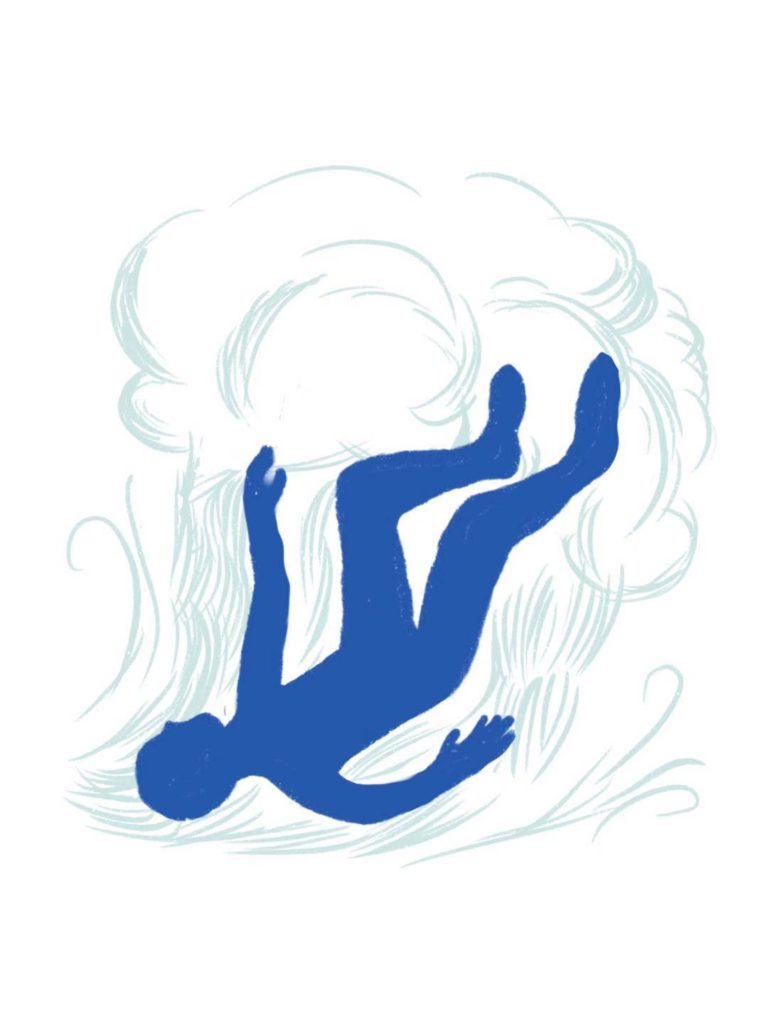
Suggested poems for comparison:
- Farewell Love and all thy Laws for ever by Sir Thomas Wyatt
In his later work, Wyatt rejected his Petrarchan influences and wrote anti-Petrarchan poems. In this poem, Wyatt’s speaker bids goodbye to love and dedicates his life to the study of philosophy instead.
- Warming Her Pearls by Carol Anne Duffy
A fantastic modern rendition of the classic unrequited love story, Duffy’s poem is narrated by a servant who harbours a secret desire for her wealthy mistress. Each day her mistress asks her to wear her pearls so the cold jewellery is warmed by her skin – by the end of the poem, the pearls ‘burn’, the same word used by Wyatt in his poem.
- To His Lost Lover by Simon Armitage
A heartbreaking poem, set after a relationship has ended, in which a list of things two people will never do together is recited like a lament. As the list goes on, the feeling that the speaker’s love is as strong as ever becomes inescapable.
- Sad, Sad by Jules Laforgue
Translated from French (Triste, Triste), this wonderful, sad, melancholy, contemplative poem treads some of the same ground as Wyatt’s I Find No Peace.
Additional Resources
If you are teaching or studying I Have No Peace at school or college, or if you simply enjoyed this analysis of the poem and would like to discover more, you might like to purchase our bespoke study bundle for this poem. It costs only £2 and includes:
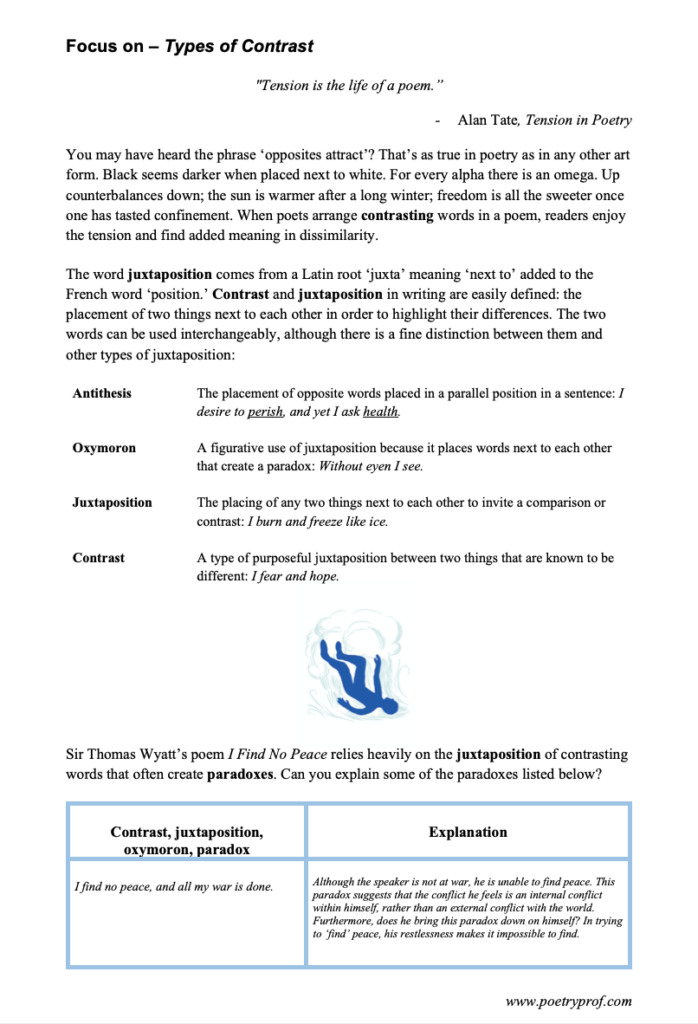
- Study Questions with guidance on how to answer in full paragraphs.
- A sample Point, Evidence, Explanation paragraph for essay writing.
- An interactive and editable powerpoint, giving line-by-line analysis of all the poetic and technical features of the poem.
- An in-depth worksheet with a focus on exploring the contrasts in this poem.
- A fun crossword quiz, perfect for a starter activity, revision or a recap.
- A four-page activity booklet that can be printed and folded into a handout – ideal for self study or revision.
- 4 practice Essay Questions – and one complete model Essay Plan.
And… discuss!
Did you enjoy this breakdown of Thomas Wyatt’s I Have No Peace? Does the internal struggle depicted in the poem ring any bells for you? Why not share your ideas, ask a question, or leave a comment for others to read below. For daily nuggets of analysis and all-new illustrations, find and follow Poetry Prof on Instagram.